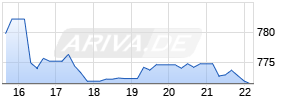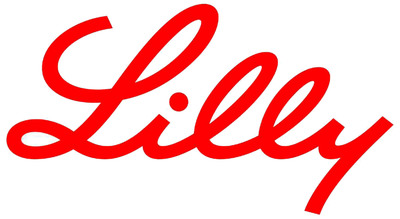
Emergency Use Authorization for Lilly's bamlanivimab and etesevimab administered together expanded to include post-exposure prophylaxis for COVID-19
PR Newswire
INDIANAPOLIS, Sept. 16, 2021
INDIANAPOLIS, Sept. 16, 2021 /PRNewswire/ -- The U.S. Food and Drug Administration (FDA) has expanded the Emergency Use Authorization (EUA) for bamlanivimab 700 mg and etesevimab 1400 mg administered together to include post-exposure prophylaxis (PEP) in certain individuals for the prevention of SARS-CoV-2 infection, Eli Lilly and Company (NYSE: LLY) announced today. The neutralizing antibodies can now be used together to treat high-risk individuals 12 years of age and older who have not been fully vaccinated against COVID-19 or are not expected to mount an adequate immune response to complete vaccination, and have been exposed to someone infected with SARS-CoV-2 or who are at high risk of exposure in an institutional setting, including a nursing home or prison. This authorization follows the national reopening of distribution earlier this month.
"Despite very significant improvements to public health resulting from COVID-19 vaccination, with the rise of the highly contagious Delta variant, the virus continues to have a devastating impact on the most vulnerable individuals, including nursing home residents and individuals with medical conditions that put them at high risk for the most severe outcomes," said Daniel Skovronsky, M.D., Ph.D., Lilly's chief scientific and medical officer, and president of Lilly Research Laboratories. "We're pleased that this expansion will help us provide antibody therapies as post-exposure prophylaxis to help prevent the spread of COVID-19 to some of the most at-risk individuals in the U.S."
The expanded authorization is based on data from BLAZE-2, a study conducted in partnership with the National Institute of Allergy and Infectious Diseases (NIAID), part of the National Institutes of Health (NIH), and the COVID-19 Prevention Network (CoVPN), that enrolled residents and staff at long-term care facilities, commonly referred to as nursing homes, across the U.S. In this placebo-controlled Phase 3 study, bamlanivimab 4200 mg reduced the risk of contracting symptomatic COVID-19 by up to 80 percent in nursing home residents and up to 57 percent among residents and staff of long-term care facilities.
"Recent reports suggest that fully vaccinated residents of nursing homes have contracted COVID-19, some of whom became quite ill," said Myron Cohen, M.D., director of UNC's Institute for Global Health and Infectious Diseases and a CoVPN leader. "This additional emergency use authorization of monoclonal antibodies for post-exposure prophylaxis in addition to the treatment of COVID-19 offers a significant achievement in the fight against this pandemic."
Since the beginning of the pandemic, Lilly has mobilized the company's scientific and medical expertise to fight this terrible disease. Lilly's bamlanivimab was the first neutralizing monoclonal antibody to be granted emergency use authorization from the FDA as a treatment for mild to moderate COVID-19 — providing a valuable therapy at a time in the U.S. when cases were increasing to their highest level. Lilly now only supplies bamlanivimab and etesevimab together in the U.S.
"In just months, Lilly achieved what usually takes years by bringing multiple therapies to patients under emergency use authorizations," continued Skovronsky. "Since then, over 535,000 treatment courses of bamlanivimab or bamlanivimab and etesevimab together have been administered to patients, potentially preventing more than 25,000 hospitalizations and 10,000 deaths during the worst of the pandemic in the U.S."
Pseudovirus and authentic virus studies demonstrate that bamlanivimab and etesevimab together retain neutralization activity against the Alpha and Delta variants. On September 2nd, the Office of the Assistant Secretary for Preparedness and Response (ASPR), alongside the U.S. Food and Drug Administration (FDA), resumed the shipment and distribution of bamlanivimab and etesevimab administered together.
For more information about the use of bamlanivimab and etesevimab together for the treatment of mild to moderate COVID-19 and prevention of COVID-19 in high-risk patients under the FDA's emergency use authorization, please see the Fact Sheet for Healthcare Providers, and Fact Sheet for Patients, Parents and Caregivers (English) (Spanish), click here or contact Lilly's 24-hour support line at 1-855-LillyC19 (1-855-545-5921). Patients and physicians can visit the NICA Infusion Center Locator or the HHS Therapeutics Distribution locator to find a potential therapy location.
For media resources, including product images and fact sheets, please click here.
Important Information about bamlanivimab and etesevimab together
Bamlanivimab and etesevimab together have not been approved by the FDA for any use. It is not known if bamlanivimab and etesevimab together are safe and effective for the treatment or post-exposure prophylaxis of COVID-19.
Bamlanivimab and etesevimab together are authorized under Emergency Use Authorization only for the duration of the declaration that circumstances exist justifying the authorization of the emergency use under Section 564(b)(1) of the Act, 21 U.S.C § 360bbb-3(b)(1), unless the authorization is terminated or revoked sooner.
Healthcare providers should review the Fact Sheet for information on the authorized use of bamlanivimab and etesevimab together and mandatory requirements of the EUA. Please see the FDA Letter of Authorization, Fact Sheet for Healthcare Providers, and Fact Sheet for Patients, Parents and Caregivers (English) (Spanish) for bamlanivimab and etesevimab together.
Authorized Use and Important Safety Information
TREATMENT
Bamlanivimab and etesevimab together are authorized for the treatment of mild to moderate coronavirus disease 2019 (COVID-19) in adults and pediatric patients (12 years of age and older weighing at least 40 kg) with positive results of direct SARS-CoV-2 viral testing, and who are at high risk for progression to severe COVID-19, including hospitalization or death.
Limitations of Authorized Use: Treatment
Combined Frequency of Variants Resistant to Bamlanivimab and Etesevimab
- Bamlanivimab and etesevimab are not authorized for use in states, territories, and US jurisdictions in which the combined frequency of variants resistant to bamlanivimab and etesevimab exceeds 5%.i
- A list of states, territories, and US jurisdictions in which bamlanivimab and etesevimab are and are not currently authorized is available on the following FDA website.
Use in Patients Who Are Hospitalized or Who Require Oxygen Due to COVID-19
Bamlanivimab and etesevimab together are not authorized for use in patients:
- who are hospitalized due to COVID-19, OR
- who require oxygen therapy due to COVID-19, OR
- who require an increase in baseline oxygen flow rate due to COVID-19 in those on chronic oxygen therapy due to underlying non-COVID-19 related comorbidity.
Treatment with bamlanivimab and etesevimab together has not been studied in patients hospitalized due to COVID-19. Monoclonal antibodies, such as bamlanivimab and etesevimab, may be associated with worse clinical outcomes when administered to hospitalized patients with COVID-19 requiring high flow oxygen or mechanical ventilation.
POST-EXPOSURE PROPHYLAXIS
Bamlanivimab and etesevimab administered together are authorized for post-exposure prophylaxis of COVID-19 in adults and pediatric individuals (12 years of age or older weighing at least 40 kg) who are at high risk for progression to severe COVID-19, including hospitalization or death, and are:
- not fully vaccinatedii or who are not expected to mount an adequate immune response to complete SARS-CoV-2 vaccination (for example, individuals with immunocompromising conditions including those taking immunosuppressive medicationsiii) and
- have been exposed to an individual infected with SARS-CoV-2 consistent with close contact criteria per Centers for Disease Control and Prevention (CDC)iv or
- who are at high risk of exposure to an individual infected with SARS-CoV-2 because of occurrence of SARS-CoV-2 infection in other individuals in the same institutional setting (for example, nursing homes, prisons).
Limitations of Authorized Use: Post-Exposure Prophylaxis
- Bamlanivimab and etesevimab are not authorized for use in states, territories, and US jurisdictions in which the combined frequency of variants resistant to bamlanivimab and etesevimab exceeds 5%. i
- A list of states, territories, and US jurisdictions in which bamlanivimab and etesevimab are and are not currently authorized is available on the following FDA website.
- Post-exposure prophylaxis with bamlanivimab and etesevimab is not a substitute for vaccination against COVID-19.
- Bamlanivimab and etesevimab together are not authorized for pre-exposure prophylaxis for prevention of COVID-19.
Important Safety Information
There are limited clinical data available for bamlanivimab and etesevimab together. Serious and unexpected adverse events may occur that have not been previously reported with bamlanivimab and etesevimab together.
Warnings and Precautions
Hypersensitivity Including Anaphylaxis and Infusion-Related Reactions
Serious hypersensitivity reactions, including anaphylaxis, have been observed with administration of bamlanivimab and etesevimab. If signs and symptoms of a clinically significant hypersensitivity reaction or anaphylaxis occur, immediately discontinue administration and initiate appropriate medications and/or supportive care.
Infusion-related reactions, occurring during or up to 24 hours after infusion, have been observed with administration of bamlanivimab and etesevimab together. These reactions may be severe or life threatening. Signs and symptoms of infusion-related reactions may include:
- fever, difficulty breathing, reduced oxygen saturation, chills, fatigue, arrhythmia (e.g. atrial fibrillation, sinus tachycardia, bradycardia), chest pain or discomfort, weakness, altered mental status, nausea, headache, bronchospasm, hypotension, hypertension, angioedema, throat irritation, rash including urticaria, pruritus, myalgia, vasovagal reactions (e.g. presyncope, syncope), dizziness, and diaphoresis.
Consider slowing or stopping the infusion and administer appropriate medications and/or supportive care if an infusion-related reaction occurs.
Hypersensitivity reactions occurring more than 24 hours after the infusion have also been reported with the use of bamlanivimab and etesevimab under Emergency Use Authorization.
Clinical Worsening After Receiving Bamlanivimab and Etesevimab Administration
Clinical worsening of COVID-19 after administration of bamlanivimab and etesevimab together has been reported and may include signs or symptoms of fever, hypoxia or increased respiratory difficulty, arrhythmia (e.g., atrial fibrillation, sinus tachycardia, bradycardia), fatigue, and altered mental status. Some of these events required hospitalization. It is not known if these events were related to bamlanivimab and etesevimab use or were due to progression of COVID-19.
Limitations of Benefit and Potential Risk in Patients with Severe COVID-19
Treatment with bamlanivimab and etesevimab has not been studied in patients hospitalized due to COVID-19. Monoclonal antibodies, such as bamlanivimab and etesevimab, may be associated with worse clinical outcomes when administered to hospitalized patients with COVID-19 requiring high flow oxygen or mechanical ventilation. See Limitations of Authorized Use.
Adverse Reactions
Adverse reactions observed in those who have received bamlanivimab and etesevimab are anaphylaxis (n=1, 0.07%) and infusion-related reactions (n=16, 1.1%). The most common treatment-emergent adverse events included nausea, dizziness, and pruritus. No treatment-emergent events occurred in more than 1% of participants and rates were comparable to placebo.
Use in Specific Populations
Pregnancy
There are insufficient data to evaluate a drug-associated risk of major birth defects, miscarriage, or adverse maternal or fetal outcomes. Bamlanivimab and etesevimab together should only be used during pregnancy if the potential benefit outweighs the potential risk for the mother and the fetus.
Breastfeeding
There are no available data on the presence of bamlanivimab or etesevimab in human or animal milk, the effects on the breastfed infant, or the effects on milk production. Breastfeeding individuals with COVID-19 should follow practices according to clinical guidelines to avoid exposing the infant to COVID-19.
BM ET HCP EUA ISI 16SEP2021
About bamlanivimab and etesevimab
Bamlanivimab is a recombinant, neutralizing human IgG1 monoclonal antibody (mAb) directed against the spike protein of SARS-CoV-2. It was designed to block viral attachment and entry into human cells, thus neutralizing the virus. Bamlanivimab emerged from the collaboration between Lilly and AbCellera to create antibody therapies for the prevention and treatment of COVID-19. Lilly scientists rapidly developed the antibody in less than three months after it was discovered by AbCellera and the scientists at the National Institute of Allergy and Infectious Diseases (NIAID) Vaccine Research Center. Bamlanivimab was identified from a blood sample taken from one of the first U.S. patients who recovered from COVID-19.
Etesevimab (LY-CoV016, also known as JS016) is a recombinant fully human monoclonal neutralizing antibody, which specifically binds to the SARS-CoV-2 surface spike protein receptor binding domain with high affinity and can block the binding of the virus to the ACE2 host cell surface receptor. Point mutations were introduced into the native human IgG1 antibody to mitigate effector function. Lilly licensed etesevimab from Junshi Biosciences after it was jointly developed by Junshi Biosciences and the Institute of Microbiology, Chinese Academy of Science (IMCAS). Junshi Biosciences leads development in Greater China, while Lilly leads development in the rest of the world.
Results from a Phase 2/3 study in people recently diagnosed with COVID-19 in the ambulatory setting (BLAZE-1, NCT04427501) were published in the New England Journal of Medicine. Results from a Phase 3 study of bamlanivimab in residents and staff at long-term care facilities (BLAZE-2, NCT04497987) were published in the Journal of American Medical Association (JAMA). A Phase 2 study assessing the efficacy and safety of bamlanivimab alone, and bamlanivimab with other neutralizing antibodies versus placebo for the treatment of symptomatic low-risk COVID-19 in the outpatient setting (BLAZE-4. NCT04634409) has completed enrollment.
About Lilly's COVID-19 Efforts
Lilly is bringing the full force of its scientific and medical expertise to attack the coronavirus pandemic around the world. Existing Lilly medicines are being studied to understand their potential in treating complications of COVID-19, and the company is collaborating with partner companies to discover and develop novel antibody therapies for COVID-19. Click here for resources related to Lilly's COVID-19 efforts.
About Eli Lilly and Company
Lilly is a global health care leader that unites caring with discovery to create medicines that make life better for people around the world. We were founded more than a century ago by a man committed to creating high-quality medicines that meet real needs, and today we remain true to that mission in all our work. Across the globe, Lilly employees work to discover and bring life-changing medicines to those who need them, improve the understanding and management of disease, and give back to communities through philanthropy and volunteerism. To learn more about Lilly, please visit us at www.lilly.com and www.lilly.com/news. P-LLY
Lilly Cautionary Statement Regarding Forward-Looking Statements
This press release contains forward-looking statements (as that term is defined in the Private Securities Litigation Reform Act of 1995) about bamlanivimab (LY-CoV555) and etesevimab (LY-CoV016) together as a potential therapy for patients with COVID-19, as well as bamlanivimab (LY-CoV555) alone, the supply, distribution and contracts with the governments relating to these therapies, and Lilly's development plans, and reflects Lilly's current beliefs and expectations. However, as with any such undertaking, there are substantial risks and uncertainties in the process of drug research, development and commercialization. Among other things, there can be no guarantee that future study results will be consistent with the results to date, that bamlanivimab and etesevimab together or any other therapy will prove to be safe and effective treatments or successful preventative therapies for COVID-19, that bamlanivimab and etesevimab together or any other therapy will receive regulatory approvals or additional authorizations, that patients will volunteer to participate in clinical trials or achieve positive outcomes, that Lilly will obtain any additional purchase orders or supply contracts, or that Lilly can provide an adequate supply of bamlanivimab and etesevimab together or any other therapy in all circumstances. For a further discussion of these and other risks and uncertainties that could cause actual results to differ from Lilly's expectations, please see Lilly's most recent Forms 10-K and 10-Q filed with the U.S. Securities and Exchange Commission. Lilly undertakes no duty to update forward-looking statements.
PP-BE-US-0105 09/2021 ©Lilly USA, LLC 2021. All rights reserved.
i FDA will make this determination considering current variant frequency data (available at: https://www.cdc.gov/coronavirus/2019-ncov/cases-updates/variant-proportions.html), trends in variant frequency over time, the precision of the estimates and information regarding emerging variants of concern. FDA will update the list of states, territories, and US jurisdictions in which bamlanivimab and etesevimab are and are not currently authorized as new data and information becomes available. Healthcare providers should refer to the FDA website regularly for updates.
ii Individuals are considered to be fully vaccinated 2 weeks after their second vaccine dose in a 2-dose series (such as the Pfizer or Moderna vaccines), or 2 weeks after a single-dose vaccine (such as Johnson & Johnson's Janssen vaccine). See this website for more details: https://www.cdc.gov/coronavirus/2019-ncov/vaccines/fully-vaccinated.html#vaccinated.
iii See this website for more details: https://www.cdc.gov/coronavirus/2019-ncov/science/science-briefs/fully-vaccinated-people.html.
iv Close contact with an infected individual is defined as: being within 6 feet for a total of 15 minutes or more, providing care at home to someone who is sick, having direct physical contact with the person (hugging or kissing, for example), sharing eating or drinking utensils, or being exposed to respiratory droplets from an infected person (sneezing or coughing, for example). See this website for additional details: https://www.cdc.gov/coronavirus/2019-ncov/if-you-are-sick/quarantine.html.
| Refer to: | Allison Howell, howell_allison@lilly.com, 317-655-1106 (Media) |
| | Dani Barnhizer, dbarnhizer@lilly.com, 317-607-6119 (Media) |
| | Kevin Hern; hern_kevin_r@lilly.com; 317-277-1838 (Investors) |
![]() View original content to download multimedia:https://www.prnewswire.com/news-releases/emergency-use-authorization-for-lillys-bamlanivimab-and-etesevimab-administered-together-expanded-to-include-post-exposure-prophylaxis-for-covid-19-301379101.html
View original content to download multimedia:https://www.prnewswire.com/news-releases/emergency-use-authorization-for-lillys-bamlanivimab-and-etesevimab-administered-together-expanded-to-include-post-exposure-prophylaxis-for-covid-19-301379101.html
SOURCE Eli Lilly and Company

Mehr Nachrichten zur Eli Lilly and Company Aktie kostenlos abonnieren
(Mit der Bestellung akzeptierst du die Datenschutzhinweise)

Hinweis: ARIVA.DE veröffentlicht in dieser Rubrik Analysen, Kolumnen und Nachrichten aus verschiedenen Quellen. Die ARIVA.DE AG ist nicht verantwortlich für Inhalte, die erkennbar von Dritten in den „News“-Bereich dieser Webseite eingestellt worden sind, und macht sich diese nicht zu Eigen. Diese Inhalte sind insbesondere durch eine entsprechende „von“-Kennzeichnung unterhalb der Artikelüberschrift und/oder durch den Link „Um den vollständigen Artikel zu lesen, klicken Sie bitte hier.“ erkennbar; verantwortlich für diese Inhalte ist allein der genannte Dritte.





